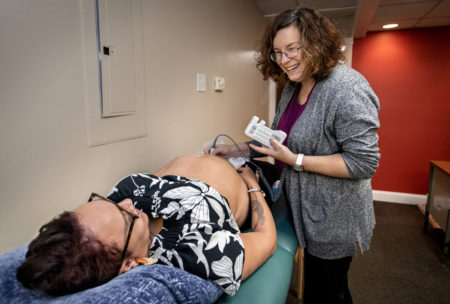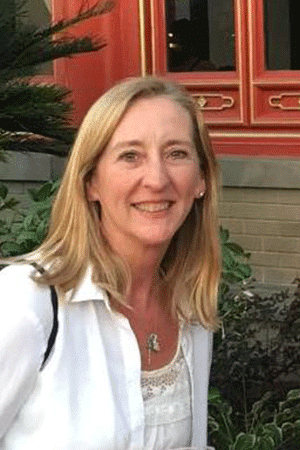By Harriet Jones
Recommend Tweet Email Print More

Midwife Carolyn Greenfield examines Cameron English of Middletown. They hear the baby’s heartbeat for the first time. English will deliver her fifth child at her home. Melanie Stengel Photo.
Cameron English got comfortable on the cushioned green exam table as her 3-year-old son and 5-year-old daughter played nearby. Initially, as midwife Carolyn Greenfield swept a monitor over English’s pregnant belly, there was only an indistinct swoosh. But before long, the instrument found and amplified a distinctive, quick double thump.
English was all smiles, hearing her baby’s heartbeat for the first time.
After English’s first three children were born in a hospital, she had her fourth child at home in 2020, attended by Greenfield, a certified professional midwife. She wants the same experience for this baby due next March. While she says she had always been interested in giving birth at home, it was COVID-19 that sealed the deal for her.
“The pandemic definitely solidified that I wanted to do a home birth,” she said. “I didn’t want all the new interventions that come with the pandemic.”
In 2019, out of a total of 34,258 births in Connecticut, 217 took place at home, according to a National Vital Statistics report issued by the Centers for Disease Control and Prevention (CDC). That proportion of home births had remained unchanged at around 0.6% of all deliveries in the state since at least 2013.
But in 2020, while the overall number of births declined slightly to 33,460, 271 women in Connecticut gave birth at home, or 0.8% of all deliveries, marking a 29% relative increase over the previous year.
That increase was mirrored nationally. According to the CDC, there were 45,646 home births across the U.S. in 2020, compared with 38,506 in 2019, an increase of 22%. The percentage of home births in the U.S. rose from 1.03% in 2019 to 1.26% in 2020. That marked the highest level since at least 1990.
Many women, like English, cite hospital restrictions imposed during the height of the pandemic, such as who can attend a live birth and who can visit, as reasons for choosing a home birth rather than a hospital birth.

English said the home birth lived up to her expectations. “It was beautiful. I absolutely loved my experience. It was so peaceful before, during and after,” she said.
A study published in May analyzed internet search data and found a 239% increase across the U.S. in relative search volumes for information on home birth since the beginning of the pandemic. The highest volume of searches occurred between March and May 2020 as the first wave of coronavirus peaked.
Birthing Center Saw Influx Too
Cathy Parisi, midwife director of the Connecticut Childbirth & Women’s Center in Danbury, said the facility historically averages around 100 births a year. But in 2021, they are on track to deliver 140 babies, making it the busiest year in the center’s history, she said.

“They got dropped off at the door to have their baby— I mean, that’s asinine!” Parisi said. “It didn’t last for very long, but it had a significant effect, I think, on how women were looking at institutions and health care providers and wondering what was really going to be able to work well for them.”
In Connecticut, hospitals initially imposed some restrictions allowing just one support person during a birth.
At the Danbury facility, only certified nurse midwives attend to women, and neither induction nor epidurals are offered. Women can labor in water and are offered massage. Typically, they can go home between four and six hours after delivery.
Parisi describes the center as a great option for those women who don’t want to be at home but do want a similar experience in a more controlled setting. “We have women who had a birth experience in the hospital who just felt that they would feel safer in a birth center,” she said. “They would feel safer not going into a hospital.”
Amy Walfish was one of them. She lives in Manhattan, and she had her first child at Mount Sinai West. She was halfway through her second pregnancy when the pandemic hit.
“I think everybody just started scrambling,” Walfish said. “It was definitely a lot of late-night talks with my husband about what is our Plan B here.”
Walfish said she thoroughly researched home birth, including attending an informational Zoom session organized by the NYC Homebirth Collective, but decided, in the end, it was not for her. Then she remembered a high school friend who had recommended the Connecticut Birthing Center.
“I called up, made an appointment. There was no friction. The birthing center just felt like such a safer option,” she said.
Recent research has discussed whether the pandemic will lead to a change in maternity care practices and protocols. In one article published in Medical Anthropology, the authors conclude that “COVID-19 is stimulating debates about the efficacy of maternity care, the safety of hospital versus out-of-hospital births, and the lack of integration of midwives in the U.S. healthcare system.”
At the start of the pandemic, the Foundation for the Advancement of Midwifery (FAM) issued a statement saying that midwives should be treated as care providers, reimbursed for midwifery care at 100% of the rate of physicians for the same service, whether from insurance or Medicaid.
For midwife Carolyn Greenfield, the prenatal consultation with Cameron English was something of a milestone because it was the first visit in her new office in Rocky Hill. Previously, Greenfield ran her midwifery practice exclusively out of her car.
Greenfield began her business in September of 2019. In the next four months, she had just one mother to care for.
Then came March 2020, and everything changed.
“I remember telling my husband, do you know what this means?” Greenfield said, recalling the announcement of a statewide lockdown in response to the coronavirus pandemic.
“My phone started ringing off the hook,” she said. From March 2020 to November of 2021, she attended 36 births in homes across Connecticut and Massachusetts.
Support Our Work
The Conn. Health I-Team is dedicated to producing original, responsible, in-depth journalism on key issues of health and safety that affect our readers, and helping them make informed health care choices. As a nonprofit, we rely on donations to help fund our work. Donate Now


